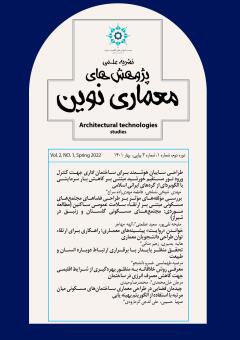بررسی مؤلفههای مؤثر بر طراحی فضاهای مجتمعهای مسکونی مبتنی بر ارتقاء سلامت عمومی ساکنین (مطالعه موردی: مجتمعهای مسکونی گلستان و زنبق در شیراز)
محورهای موضوعی :
ملیحه تقی پور
1
,
سعید عظمتی
2
![]() ,
الهه مهاجر
3
,
الهه مهاجر
3
![]()
1 - 1. دانشیار گروه معماری، دانشکده هنر و معماری، واحد شیراز، دانشگاه آزاد اسلامی، شیراز، ایران
2 - 2. استادیار گروه معماری، دانشکده هنر و معماری، واحد تهران شرق، دانشگاه آزاد اسلامی، تهران، ایران (نویسنده مسئول)
3 - 3. دانشجوی دکتری، گروه معماری، دانشکده هنر و معماری، واحد شیراز، دانشگاه آزاد اسلامی، شیراز، ایران
کلید واژه: معماری شفابخش, مجتمعهای مسکونی, سلامت عمومی.,
چکیده مقاله :
در عصر حاضر در جوامع شهری و صنعتی، تأثیرات منفی محیط بر افراد و شیوع اختلالات روانی ضرورت توجه به سلامت در محیط را بیش از پیش آشکار میسازد. باتوجه به این موضوع، فضاهای شفابخش را میتوان نیاز زندگی پرتنش امروز دانست. فضای مسکونی در بین فضاهایی که انسان در طول روز با آن سروکار دارد بیشترین سهم را دارا میباشد و به بیشترین میزان بر فرد تأثیرگذار است، بنابراین بهتراست به گونهای طراحی شود که متضمن سلامت عمومی ساکنین باشد. هدف پژوهش حاضر ارائهی مؤلفههای تأثیرگذار بر ارتقاء سلامت عمومی ساکنین در مجتمعهای مسکونی میباشد. این پژوهش به روش ترکیبی (کمی- کیفی) انجام شده است، در مرحلهی نخست پس از معرفی مفاهیم اولیه، شاخصههای شفابخش معماری از پیشینهی پژوهش استخراج شده که مبنایی برای پرسشنامهی محقق ساخت خواهد بود. جمع آوری دادهها با ارائهی پرسشنامهی محقق ساخت و پرسشنامهی استاندارد سلامت عمومی (GHQ) و سلامت اجتماعی کییز (KSWBQ) به ساکنین مجتمعهای مسکونی زنبق و گلستان در شیراز صورت پذیرفته است و دادههای بدست آمده به وسیلهی نرمافزار Spss-23 و با استفاده از تحلیلعاملی، آزمون همبستگی پیرسون و آزمون فریدمن مورد تحلیل قرار گرفته و در نهایت مؤلفهها مورد بحث و بررسی قرار گرفتهاند. باتوجه به نتایج حاصله مؤلفههای مؤثر بر طراحی مجتمعهای مسکونی مبتنی بر ارتقاء سلامت عمومی ساکنین شامل: فضاها و فعالیتهای متنوع، ایمنی و امنیت محیط، خلوت و محرمیت، آسایش محیطی، لذتبخشی و جذابیت محیط و تعاملات اجتماعی میباشد. از بین این مؤلفهها بالاترین میانگین رتبه به مؤلفهی تعاملات اجتماعی و پایینترین رتبه نیز به مؤلفهی فضاها و فعالیتهای متنوع اختصاص دارد.
In the present age in urban and industrial societies, the environment's negative effects on the psyche of individuals and the prevalence of mental disorders make a need to pay attention to public health. Based on this fact, healing spaces are required for a daily stressful life. Residential areas have the largest share among where human beings deal during the day and have the most significant impact on the individual. So, these spaces should be designed to provide mental and physical health for residents. This study aims to provide effective components for promoting the general health of residents in residential complexes. This research has been done by a combined method (quantitative-qualitative). In the first stage, after introducing the basic concepts, healing architecture characteristics have been extracted from the research background, which will be the basis for the researcher-made questionnaire. Data collection was conducted by presenting a researcher-made questionnaire, a standard general health questionnaire (GHQ), and Keyes's Social Well-being questionnaire (KSWBQ) to the residents of Zanbagh, Civil and development residential complexes in Shiraz. Finally, the data obtained by Spss-23 software were analyzed using factor analysis, Pearson correlation, and the Friedman test. According to the results, the effective design components of residential complexes include various spaces and activities, environmental safety and security, privacy, environmental well-being, environmental pleasure and attractiveness, and social interactions based on promoting the general health of residents. Among these factors, the highest mean rank belongs to the component of social interactions, and the lowest one belongs to the component of various spaces and activities.


